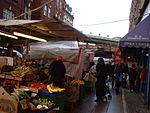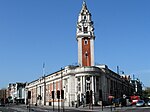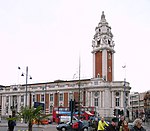The Ritzy is a cinema in Brixton, London, England. It is a Grade II listed building. It is managed by Picturehouse Cinemas, who were bought by Cineworld in 2012.
The cinema opened on 11 March 1911 as "the Electric Pavilion". It was built by E.C. Homer and Lucas for Israel Davis, one of a noted family of cinema developers, and was one of England's earliest purpose-built cinemas, seating over 750 seats in the single auditorium. Like many cinemas of the period, it was fitted with an organ. It was seen as a 'scruffy relation' to the nearby Palladium, and was known as the 'flea pit'. Sound films began showing in 1929.The neighbouring Brixton Theatre was completely destroyed by bombing in 1940, which allowed the Ritzy to expand into the vacant space.In 1954, it was renovated by noted cinema architect George Coles, who installed CinemaScope: the cinema was renamed "the Pullman" and the organ was removed. It was later renamed "the Classic", before closure in 1976. After this, it was re-invented as "The Little Bit Ritzy", run in collaboration with London Cinema Collective. A collaboration between Lambeth Council and the management of the time ensured the cinema's survival, with the facade being rebuilt and restored to near-original condition.During the 1980s, the cinema developed a reputation as having a left-wing agenda, so much so that the incumbent manager was motivated to place an advert in the local press advising potential patrons that not every film that the cinema screened was "left-wing or gay".Today, the cinema is owned by Picturehouse Cinemas, and operates as a multi-screen complex with bar and café facilities. Its official name is now "Ritzy Picturehouse" although it is still commonly known as the Ritzy Cinema. In 1999, Albion Ventures invested £8million in Picturehouse to help fund the development of several of their cinemas, including the Ritzy.
In 2009, the decor and colour scheme was restored from its original style and a live music venue was added, called Upstairs.











